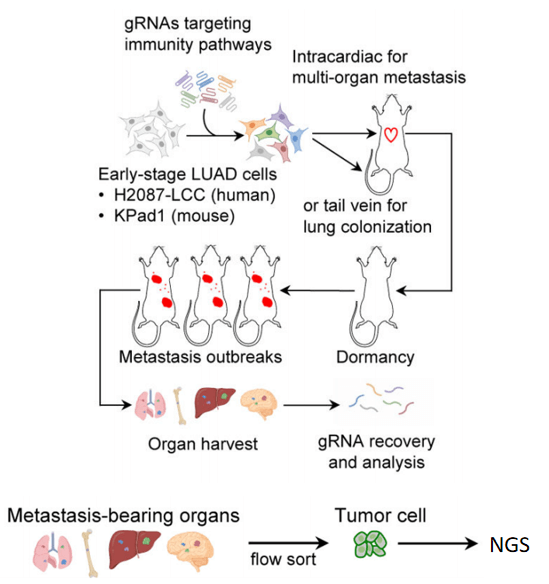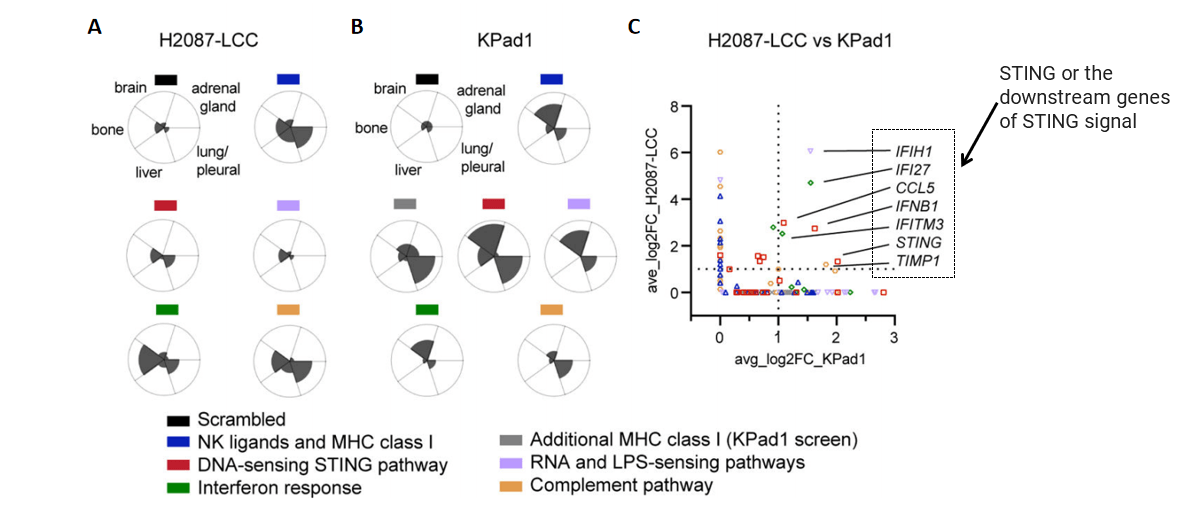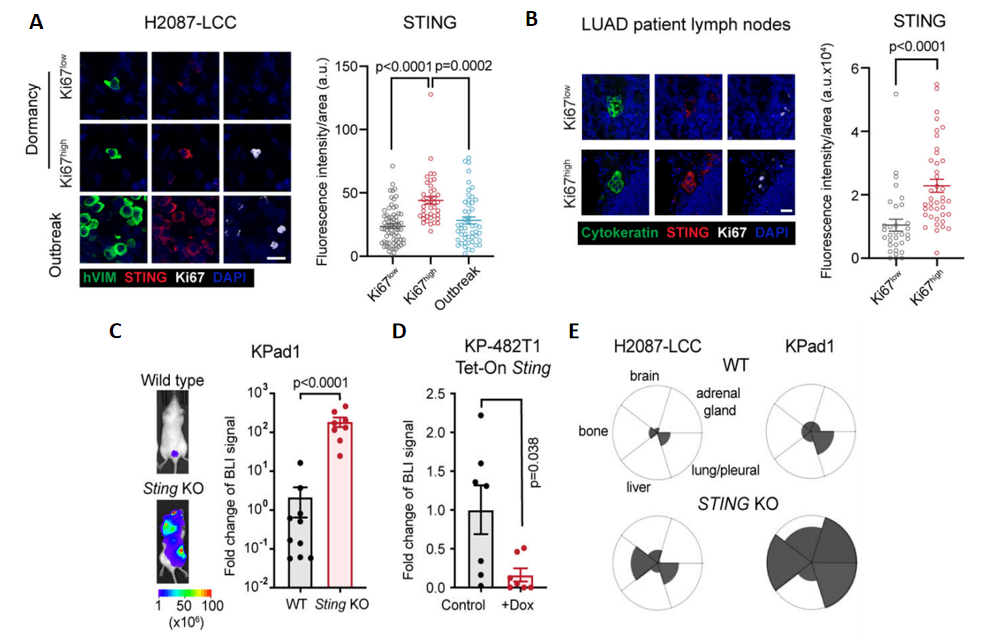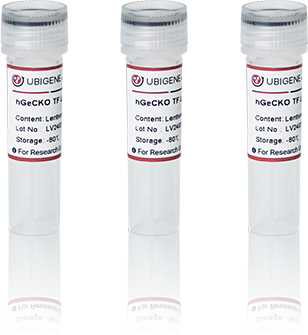Advanced method of using CRISPR library! Check out the target screening ideas from a Nature article

The most critical and difficult step in scientific research is to find a target. Screening a new target means the birth of a good research article. As a powerful target screening tool, CRISPR library has set off a new wave of scientific research. I believe you have a certain understanding of the basic principle and operation process of CRISPR screening library, but you may also strive to fully utilize the CRISPR library to screen the target. To quickly gather the information and provide the ideas for you as uaual, here, we are going to share the screening ideas from a CRISPR library screening case published on Nature this year!

The vast majority of tumor cells shed from orthotopic tumors will be eliminated by the immune system in the process of metastasis, but there are still a small number of cells that escape the recognition of the immune system and reside in other organs and enter the dormant period. These cells are called disseminated tumor cells (DTC). DTC in dormant phase will downregulate the expression of NK cell-activating ligands and MHC-I to evade the recognition of NK cells and T cells. After a period of dormancy, these cells will restart proliferation and enter the incipient metastasis stage. DTC in this stage is in the balance of immune escape and easy to be recognized by the immune system. Finally, DTC escapes recognition by the immune system, proliferates explosively, and forms new macrometastasis.
This research mainly focused on finding out the immune factors that inhibit the tumor cell outbreaks in the incipient metastasis stage. The study screened immune activating factors through CRIPSRko library, compared the differences between cells at the incipient metastasis stage and those after the formation of new macrometastasis, and found that STING signal inhibited the reactivation of dormant metastasis of lung adenocarcinoma cells.

Figure 1. Tumor cell metastasis escape model [1,2]
Next, let's see how the CRISPR library screening of this study was done.
Step 1: Design sgRNA for library screening
Highlighted Tips: Customize the targeted sgRNA library according to the research purpose (small and precise library)
Because the main purpose of this study is to find the genes related to immune escape of DTC, the sgRNA library of this study was mainly designed based on the genes related to autoimmune activation of DTC cells.
The designed sgRNA can be divided into 3 parts, targeting a total of 220 genes.
- NK cell-activating ligands and MHC-I-related genes (DTC will be recognized and killed by NK cells and T cells through both);
- interferon-α/γand complement system related genes (scRNA-Seq compared DEGs between cells at the incipient metastasis stage and cells after outbreaks, and GSEA analysis found that these signaling pathways were significantly enriched);
- STING, RNA, and lipopolysaccharide signaling pathway genes (these pathways are located in the upstream of the interferon-α).
To ensure the representativeness of the library cells injected into mice, the research team divided the above genes into several sub-libraries (each sub-library targeted 20 genes, 5 sgRNAs were designed per gene)
Step 2: Library transfection
Human early lung adenocarcinoma cell lines (H2087-LCC and KPad1) were used in this study. To ensure the high representativeness of the library cells, the sub-libraries were transferred into different cell populations by lentiviral infection under the conditions of MOI = 0.3 and coverage >1000x. After treatment with puromycin (2.5μg/mL, 4 days) as the antibiotics screening, the infected cells with different sub-libraries were obtained.
Step 3: Develop a suitable screening proposal
Highlighted Tips:1) The mouse tumor model was combined with flow cytometry to screen the target cells; 2) Parallel experiments of two different cells increase the persuasion of the experimental results.
This study aimed to find out the differencebetween cancer cells in the incipient metastasis stage and cells in the outbreak stage. Early research by the team showed that injecting early lung adenocarcinoma cells into immunodeficient mice would make them metastasize to multiple organs and proliferate rapidly. Therefore, early lung adenocarcinoma cells were chosen to be injected into immuno-deficient mice to promote their eruption. Then the outbreak cancer cells in different organs were sorted by flow cytometry for subsequent experiments.
Cell type: Human early lung adenocarcinoma cell lines (H2087-LCC and KPad1)
Experimental model: immunodeficient mice
Comparison groups: DTC in the incipient metastasis stage (Control group) and DTC after outbreaks
Treatment conditions: cells were intracardially or intravenously injected; Observation of cell conditions by living imaging until outbreaks
Screening method: different tissues were collected, and fluorescently labeled tumor cells were sorted by flow cytometry

Figure 2. Flowchart of CRISPR library screening[1]
Step 4: Find out the target genes by bioinformatics analysis
Highlighted Tips: Comparative analysis of sequencing results of two parallel experimental groups to find the targets.
By comparing and analyzing the sgRNA differences between the experimental group and the control group in different tissues through bioinformatics analysis, the researchers found that the enrichment of sgRNAs corresponding to NK cell-activating ligands and MHC-1 was the highest; As previous studies have shown that NK cells and T cells inhibit the transfer of dormant cells, it shows the reliability of the screening results. Further combined analysis and comparison of sgRNA differences between two early lung adenocarcinoma cells revealed that STING signals and the downstream genes of STING signal were the main targets of sgRNA.

Figure 3. Screening targets by bioinformatics analysis[1]
- In H2087-LCC cell infection group, sgRNA enrichment levels in different tissues;B. In Kpad1 cell infection group, sgRNA enrichment levels in different tissues; C. sgRNA enrichment analysis of the above two groups of cells
Step Five: Target validation
The researchers first confirmed by immunofluorescence that STING signal was significantly upregulated in lung adenocarcinoma cells at the incipient metastasis stage, and then demonstrated the relationship between STING signal and tumor cell reactivation at the incipient metastasis stage in immuno-deficient mice by Sting gene knockout and overexpression, respectively. Inhibiting STING signal can promote the explosive proliferation of tumor cells at the incipient metastasis stage, while enhancing STING signal can slow down its proliferation.

Figure 4. Target validation of STING[1]
A&B.Comparison of STING signal intensity in two cell lines. Compared with the dormant cells (Ki67low), the STING signal of the cells at the incipient metastasis stage (Ki67high) was significantly increased; C. Knockout of Sting gene in KPad1 cells significantly increased the proliferation of tumor cells; D. Expression of Sting gene by Tet-On system significantly inhibited the proliferation of tumor cells; E. After the knockout of Sting gene, tumor cells in all organs significantly proliferated.
Conclusion
Here is the end of the main content of sharing the article about the CRISPR library screening. Last, let’s make a summary for you!
The steps of CRISPR library screening:
1) Select the sgRNA library; At present, whole genome libraries and sub-libraries targeting multiple signaling pathways are available on the market to meet the needs of most researchers. Of course, libraries can also be customized according to your own experimental needs (for example, DEGs screened by RNA-Seq, candidate gene groups by KEGG, GO, GSEA analysis, etc.).
2) Develop screening proposal; According to your own experimental needs, consider drug screening conditions (concentration, duration), cell screening methods (positive/negative screening, in vivo/in vitro screening, flow sorting) and comparison objects (experimental group and control group), formulate a reasonable screening strategy.
3) Bioinformatics analysis; Potential targets can be screened by comparing the differential gene enrichment between the experimental group and the control group.
4) The function of the target can be verified by gene knockout or overexpression cells, or the downstream signaling pathway mechanism can be further studied.
Hope you have gained some thoughts after reviewing this paper. And please do not hesitate to subscribe to us, we will share more high-scored articles and CRISPR screening strategies with you!
Reference:
[1] Hu, J., Sánchez-Rivera, F.J., Wang, Z. et al. STING inhibits the reactivation of dormant metastasis in lung adenocarcinoma. Nature 616, 806–813 (2023).
[2] Laughney, A.M., Hu, J., Campbell, N.R. et al. Regenerative lineages and immune-mediated pruning in lung cancer metastasis. Nat Med 26, 259–269 (2020).
 Subscribe Us
Subscribe Us Gene Editing Services
Gene Editing Services
 EZ-editor™
EZ-editor™ Red Cotton Gene knockout Project
Red Cotton Gene knockout Project



















